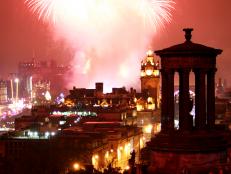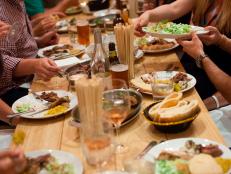Lucky Eats: New Year's Day Meals Around the World
It’s not just beans and greens. See what other countries eat for good luck while ringing in the new year.

Related To:
lessRelated To:
USA
In the South, it’s all about the beans 'n' greens on New Year’s Day. Beans represent luck and greens represent money. Typically, collard greens and black-eyed peas are served as sides but, in Charleston, a rice and bean dish called Hoppin’ John is popular.
Spain
On New Year’s Eve at the stroke of midnight, the Spanish eat 12 grapes in 12 seconds! Each grape represents a month in the new year and luck and prosperity for each month.
Sweden
Rice pudding with cinnamon and cardamon is a popular treat throughout the winter holidays in Sweden. But on New Year’s, a single almond is placed in the batch. Whoever finds/eats the almond is supposed to be blessed with good fortune for the next year.
South Korea
For the Korean Lunar New Year, TTeokguk, or rice cake soup, is served to indicate everyone becoming a year older. In the olden days, people marked their age by how many bowls of TTeokguk they’ve had. The rice cakes in the soup are sliced so thin that it almost becomes a type of pasta.
Germany
In Germany, the Berliner is a popular treat on New Years. These donuts are filled with jam and then topped off with powdered sugar. However, some like to play tricks with the filling and surprise one unlucky person with mustard!
India
In India, it’s all about the lentils--some curried, some sweet with pumpkin--because the shape of the round lentils represents gold coins. If you eat enough lentils, you’ll ensure your financial prosperity in the coming year.
Turkey
Pomegranates are very important in Turkey and on New Year’s it’s no different. The red color is considered extremely lucky. People wear red underwear on New Year’s Eve for good luck! And eating the abundant seeds represent prosperity. There’s also a tradition where people throw a pomegranate on the ground or doorstep. The more pieces it smashes into, the more luck you’ll have in the new year.
Ireland
In Ireland, some still call New Year’s Day the Day of Buttered Bread. In olden times, and during Ireland’s infamous famine, villagers would break up a piece of bread by the door to symbolize how they overcame hunger the year before and to ward off hunger in the new year. To celebrate today, make a loaf of Barm Brack or Irish Raisin Bread. It’s like a cross between fruit cake and cinnamon raisin toast. And pile on the butter!
Iran
The Persian New Year is celebrated in March to welcome the arrival of Spring. It’s all about fresh greenery with the new season and one of the most popular dishes is the very green and herb-y kuku. It’s kind of like a frittata but less eggy and with tons of cilantro, parsley and dill. Sometimes kuku is sweet with dried rose and sometimes it’s more savory with a lot of onion.
China
Chinese New Year or the Lunar New Year is the most important celebration in mainland China. Traditionally, people stayed up until midnight on New Year’s Eve making Jiaozi or dumplings and then feasted on them during the first hour of the new year. The dumplings are shaped like gold ingots, or bricks, to represent financial wealth in the coming year.
El Salvador
This tradition isn’t a meal, but it does involve food. In El Salvador, people crack an egg into a glass of water. The shape that appears in the yolk is said to represent someone’s future in the coming year.





